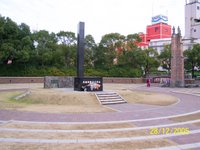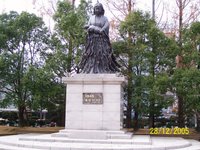© Melina Magdalena (2006)
PART TWO: Nagasaki - January, 2006
Anna and I went to Nagasaki by train. I was vaguely worried even before we got there. Radiation, like poison gas, is invisible. What happened to it all in that place? Surely it must linger somewhere in the atmosphere and dust of nowadays Nagasaki, or is just an urban myth that cars and trucks and factories and consumers have caused the thinning of the ozone layer and the greenhouse effect that is slowly strangling our planet? It’s easier to blame the consumers who have grown dependent on the industry, for our own demise, than lay the blame with scientists, industrialists and politicians.
Maybe the radiation from Nagasaki, Maralinga, Hiroshima and all those thousands of atmospheric, subterranean and ocean nuclear tests has permeated Earth’s atmosphere, and is enacting some kind of logical death-sentence consequence upon the humans who unleashed its evil power? Wanting another child, I did not wish to expose myself to high levels of radiation at Nagasaki.

I made no preparations for the journey, did no research, and had no clear expectations of what I might find there. I knew that Nagasaki was a city, larger than the one where Anna lived, and that she often went there for shopping and particular occasions, as it was the main city of the prefecture where she lived.
If it’s a city, I reasoned, than it must be safe enough. Maybe the Nagasaki we are going to in 2005 is not the same Nagasaki of 1945. Maybe it was rebuilt in a slightly different location?
(Remember at this time I had been in Japan for only two days, and was only just beginning to grasp, with my colonial baby brain, that people had been living, building, thriving just where I was walking for many thousands of years. It took a week for me to make the observation that in Japan it’s not always easy to distinguish the natural, from the manufactured, and to begin to appreciate the intertwining of the two, so that nature can in some cases be enhanced through human intervention.)
When we reached Nagasaki, we got off the train and began our day of catching streetcars and walking all over the city centre. Anna led me up a hill, towards Peace Park. As we left the station, I noticed a marker on the side of the street. It reminded me of similar markers I have seen at Japanese sites in Sydney and Australia – a simple post painted white, cut on the diagonal across the top, with black writing painted on it. I pointed it out to Anna, wondering whether it was some kind of distance marker to do with the bomb.
We walked up a steep street towards the park. It began, when I entered the park and saw the memorials adorned by wreaths of paper cranes. Most of these did not have English signs to explain them, so I could only absorb them through their actual context. A heavy sadness began to descend upon me.
There was no shrine there. This seemed fitting. I observed in Japan that shrines were mostly to be found in the most beautiful of places, celebrating or commemorating nature, not death. On the other hand, the whole place reeked of death, and in some ways, my culture equates shrines and altars, with death.
As we walked deeper into the park towards the hypocenter, I noticed that the people there were almost all Westerners. I saw a man who looked Japanese, who was, perhaps their friend or guide. I wondered what had brought us all to this park that day, and what connection we had with the bomb, Japan and World War II? I began to feel fraudulent. This was not, after all, MY personal tragedy.
As I approached the hypocenter, my breathing became shallow and I could not, in fact, bring myself to go to the centre. I stood on the perimeter of that portion of the park, wondering, imagining and trying simultaneously not to wonder, not to imagine.

There were some beautiful commemorative statues and memorials. I was particularly moved by some of them, which had been sent to Nagasaki from all over Asia and Europe. Mother and child was a recurrent theme. I analysed, with amusement, though I am no scholar of the three-dimensional form, some of the elements of Communist Europe and found it fitting that even after the wallfall and German reunification, the memorial from East Germany remains in the park.
I did not like the blue man. Even after reading what the guidebook had to say about what he symbolized, he looked monstrous and threatening to me, rather like the Incredible Hulk. I could only imagine that he was an angry threatening mutant, resulting from radiation poisoning. But from the back, he looked more at peace. Anna and I photographed him from behind. There was some kind of memorial on the back of the statue. We saw a Japanese family reading there and paying their respects.
All this was bearable. I shed a few tears, but did not disgrace myself. The sadness had descended, but had not yet overwhelmed me.

We went into the Atom Bomb Museum. It was like descending into a pit of hell. Perhaps that was the architect’s intention? We walked slowly down a spiral ramp which parodied a peaceful dome. The walls were white and unadorned, almost windowless. The roof was made of triangles of glass which to me symbolized the international sign for radiation over and over and over again.
It is a well-thought-out space. I cannot imagine anyone going into it and leaving unmoved. I did not want to be unmoved by its story. I found the endorsement of nuclear disarmament and the exhortation for peace rang very hollow though, and was barely uplifted at the end. Indeed, wandering past the testimonials and artifacts of sudden fiery death, I found the sadness pressing in on me so I could scarcely breathe anymore. It became unbearable and I asked Anna if we could leave. By this stage, tears were pouring down my face and I could no longer hide them. If I saw one more word about suffering, sickness and survival, I thought I would melt into a puddle of saltwater.
Later, while in Omura, I looked through an art magazine someone had given Anna, from Kyoto. I saw there a photograph of a state-of-the-art karaoke room, designed to resemble a bathtub, complete with fake shower head, taps and so on. It’s clichéd I’m sure, but still it made me shudder to think of a small group of people ensconced within this chamber ostensibly to make music, but who knows what sinister things might emerge from those shower heads and taps?

I had gathered myself somewhat together again by the time we reached the ramp that led to the exit, so we sat together to watch the video about nuclear testing. It was projected onto a series of split screens. The screens continued to split as the countdown continued, showing more and more flags of nations which have carried out nuclear tests. The footage of the tests outweighed the fragile footage of the protests. This disappointed me, though I had never really grasped the idea of how five million signatures by human beings of Planet Earth on one petition brought to Helsinki could be ignored as just another bunch of ratbag loser activists. (Who are the losers?)
Neither Hiroshima nor Nagasaki were my personal tragedies, but I could not go to Nagasaki without being touched or reminded of those times. I have the impression, Escher-like, of a multitude of shadows in various shades of white and grey, fluttering, fluttering, filling the space like moths. There was no flame, no light that they didn’t flee. In speech without words they managed to convey their confusion, hurt and sorrow for what had just befallen them. There was no single voice, no harmony, no unity, just a jumble of souls trying to come to terms with something no one had planned for, no one had anticipated.
 A timeline in the museum which showed the political events and correspondence which preceded the bombings of Hiroshima and Nagasaki. It was made powerfully clear, even beneath Japanese understatement and reserve, that widespread dissension had been expressed before the bombings; that there was no justification for the bombings; and the horror that they were carried out with no prior warning. Yet how could people have prepared themselves to be melted and incinerated in their streets, workplaces and homes?
A timeline in the museum which showed the political events and correspondence which preceded the bombings of Hiroshima and Nagasaki. It was made powerfully clear, even beneath Japanese understatement and reserve, that widespread dissension had been expressed before the bombings; that there was no justification for the bombings; and the horror that they were carried out with no prior warning. Yet how could people have prepared themselves to be melted and incinerated in their streets, workplaces and homes?
No comments:
Post a Comment